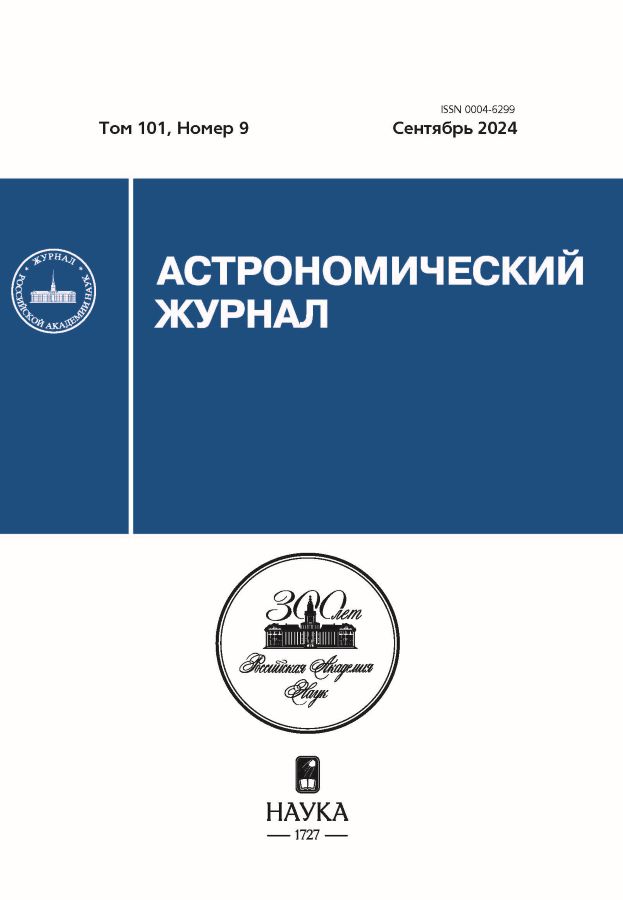Proton fluxes of solar-type stars with planetary systems
- Authors: Savanov I.S.1
-
Affiliations:
- Institute of Astronomy of the Russian Academy of Sciences
- Issue: Vol 101, No 9 (2024)
- Pages: 860-864
- Section: Articles
- URL: https://rjeid.com/0004-6299/article/view/647669
- DOI: https://doi.org/10.31857/S0004629924090065
- EDN: https://elibrary.ru/IAUUUV
- ID: 647669
Cite item
Abstract
The previously developed method for estimating of the parameters of proton fluxes from flare energies for the Sun was applied to data on the flare activity of solar-type stars. The results obtained will be used to assess the radiation situation in a stellar system containing exoplanets. In our analysis we used catalog data on flares of solar-type stars obtained from observations with Kepler telescope. The empirical relations between the energy of X-ray flares and the proton flux for the Sun was extended to the case of stellar flares, similar to what was done previously in the case of coronal mass ejections (CMEs). The method used has limitations caused by the extension of the solar analogy to other stars as well as the uncertainties that arise when applying scaling methods. It was found that the characteristic values of the proton flux for solar-type stars can be one order of magnitude higher than the estimates for the Sun. Prospects for the development of alternative methods for estimating proton fluxes in the vicinity of stars of late spectral types are discussed (for example, by studying the behavior of Si IV and He II emission lines in the far ultraviolet range).
Keywords
Full Text
About the authors
I. S. Savanov
Institute of Astronomy of the Russian Academy of Sciences
Author for correspondence.
Email: isavanov@inasan.rssi.ru
Russian Federation, Moscow
References
- V. S. Airapetian, R. Barnes, O. Cohen, G. A. Collinson, et al., Intern. J. Astrobiology 19(2), 136 (2020).
- A. Papaioannou, I. Sandberg, A. Anastasiadis, A. Kouloumvakos, et al., J. Space Weath. and Space Climat 6, id. A42 (2016).
- D. V. Reames, Space Sci. Rev. 217(6), id. 72 (2021).
- E. W. Cliver, C. J. Schrijver, K. Shibata, and I. G. Usoskin, Liv. Rev. Solar Physics 19(1), id. 2 (2022).
- V. Kurt, A. Belov, H. Mavromichalaki, and M. Gerontidou, Ann. Geophysicae 22(6), 2255 (2004).
- I. G. Usoskin, B. Kromer, F. Ludlow, J. Beer, M. Friedrich, G. A. Kovaltsov, S. K. Solanki, and L. Wacker, Astron. and Astrophys. 552, id. L3 (2013).
- A. Papaioannou, K. Herbst, T. Ramm, E. W. Cliver, D. Lario, and A. M. Veronig, Astron. and Astrophys. 671, id. A66 (2023).
- A. N. Aarnio, S. P. Matt, and K. G. Stassun, 760(1), id. 9 (2012).
- M. N. Günther, Z. Zhan, S. Seager, P. B. Rimmer, et al., Astron. J. 159(2), id. 60 (2020).
- K. Namekata, T. Sakaue, K. Watanabe, A. Asai, et al., 851(2), id. 91 (2017).
- S. Okamoto, Y. Notsu, H. Maehara, K. Namekata, S. Honda, K. Ikuta, D. Nogami, and K. Shibata, 906(2), id. 72 (2021).
- A. Struminsky and A. Sadovski, in Stars: From Collapse to Collapse, Proc. of a conference held at Special Astrophysical Observatory, Nizhny Arkhyz, Russia 3–7 October 2016; edited by Yu. Yu. Balega, D. O. Kudryavtsev, I. I. Romanyuk, and I. A. Yakunin (San Francisco: Astronomical Society of the Pacific, 2017), 510, 105 (2017).
- L. I. Miroshnichenko, Physics Uspekhi 61(4), 323 (2018).
- I. S. Savanov, Astron. Letters 46(12), 831 (2020).
- A. Youngblood, K. France, R. O. P. Loyd, A. Brown, et al., 843(1), id. 31 (2017).
Supplementary files











